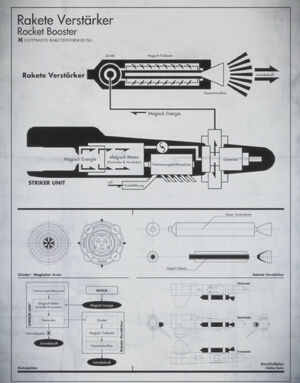
Schematic of a Striker Unit with rocket booster.
A Striker Unit is pair of hybrid mechanical/magical propeller devices used by Witches for flight and worn over their legs. They are rigid, preventing movement of the knees, but can be disengaged on the field if needed. When wearing a Striker a Witch's power is vastly increased by a magic engine in the unit, resulting in the constant manifestation of their animal ears and tails. It grants them the powers of high speed flight, increased physical abilities, and the ability to raise defensive shields.It was improved by Miyafuji Yoshika's father, Miyafuji Ichiro, in the 1930s.
At least for Land Strikers, the main armament is sometimes measured with "magic mass", mm, for example "75 mm gun" means the gun has 75 magic mass. This is an abstraction of the amount or power of magic used by the gun.
Other Striker Unit versions
Jet Strikers
Etherjet Strikers (commonly known as jet strikers) were invented by researchers in Karlsland and built in Neue Karlsland. They are faster and more powerful than an average striker unit. It was able to ascend really fast. However, only witches with strong magical capabilities as well as support from their familiar can safely use them, and it didn't seem good for flying for a long period of time. Although there are very powerful and faster, a defect in the machine caused the first test pilots to suffer from heavy magic power consumption and made they crash. The strikers has two cohets what, as the striker unit runs on magic power, the shock diamonds appear as disks similar with the rune shields used by the witches.
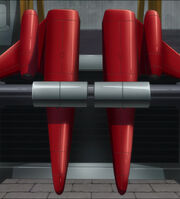
The first Jet Striker Model, Me 262 'Swallow'
While it depends on the model, Jet Strikers are usually capable of a maximum speed of about 950 km/h.
The main model of the Jet Strikers is the Messerscharf Me 262, with sub-models as the V1 and the A-1a. In May 22 of 1943, Air Commodore Adolfine Galland from the Karlslander Air Force performs a test-flight with the Me 262. Afterwards, she proposes its manufacture in an imperial conference and Frederick IV, a known lover of new technology, accepts it. Galland had high hopes in this model. Initial testing looked promising. The 262 set a new altitude record of 16,000+ meters. In spring of 1945, Ursula Hartmann developed the first Jet Striker Unit prototype, the ME-262 Swallow, which was delivered to the 501st JFW for testing. Gertrud Barkhorn tests it, and during its third test of speed Barkhorn fainted and crashed into the Adriatic sea. The Prototype was then locked away and was scheduled to be sent back for further development. After scrambling to intercept a Neuroi, the prototype fell to its destruction. The remains of it were sent back with Ursula Hartmann. Post war, development of Jet Striker prototypes became the main focus of development.
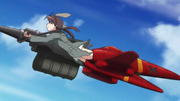
Flight with a Jet Striker
The Me 262 was superior of its contemporaries in many ways, but maintennace and reffting was time-consuming, and most importantly, the jet-powered magic engine could only be used by witches with strong magical abilities. Furthermore, the support of a familiar in magic concentration was absolutely neccesary, without which the unit would stall easily. However, the Me-262 could fully demonstrate its high speed mobility once it got into the air, where it would feel like 'angels were pushing the plane from behind'. The Jet Strikers of the 3./VEKdo squadron has thin yellow and white designation markings as his distinguishing feature. In combat, when properly flown, it proved to be essentially untouchable.
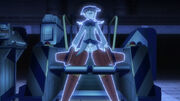
Power up the Jet Striker
Users of these sistems are known a jet-powered mechanized air infantry. The Jagdverband 44 (JV44) is a test unit of Jet Strikers under the direct command of Air Marshal Adolfine Galland, the witch with the highest military rank, newly organized by her's personal request to the Emperor for the European recapture operations. Also, the Preliminary Evaluation Squadron (Erprobungskommando) is currently performing tests on the new etherjet strikers. The squadron has been assembling accomplished and even elite veteran aces from all over the Karlsland Air Force. However, some of the members was only 13 years of age, and with a relatively short military career. Here are high expectations for them to become an aces of the new generation. Examples of Jet Strikers pilots are Helma Lennartz, Gertrud Barkhorn, Adolfine Galland, Waltrud Krupinski and Rike Sachsenberg. Witches that perform the Jet Striker has usually very heavy weapons, as the MK108 and the BK-5, because the model is designed to fight against large-scale Neuroi bombers. Those witches set a variety of altitude and speed records on prototype and experimental craft.
Land Strikers
Land Strikers are a special type of Striker Unit. "Army Witch" and even "Tank Witch" are terms often reserved for Witches using Land Strikers, but this can differ for some nations.
In the early days of development, they were mostly used for hauling large calibre cannons and anti-tank guns, for personal protection the witches just carried regular guns. Later when it was possible to release more physical strength, it became popular to equip them with their own main armament.
Unlike the air infantry Strikers, which by necessity must direct much of the magic engine output to flight magic, land combat Strikers instead place much more emphasis on shields, firepower, and boosting physical abilities.
The strength of their shields, and the firepower of their main cannons, are far beyond those of air infantry witches, and their operation times are also longer. In other words, flight magic consumes an enormous amount of magic power, which is used in other ways by land combat Strike Witches.
While it depends on the model, land Strikers are usually capable of a maximum speed of about 30 km/h. For traveling long distances, trains and railroads are normally used.
There are two modes of operation, bipedal and tracked modes. Regularly, Witche

Major Miles on point leading the Britannian Royal Army, 4th Armoured Brigade, C Squadron and the Patton Girls to come to Kitano Furuko's aid against Neuroi advancing on Egypt. The scene well Illustrates how Land Witches perform Track Dashing maneuvers with their Land Strikers.
s walk with the "feet" part of the Striker, including when engaging in combat. However, when in need of faster speed, they can also utilize the tracks equipped on the Striker Units to attain said maximum speed. These tracks can be exposed by retracting the "feet" part of the Striker Units, and engaging this tracked mode for movement is refred to as "Track Dashing".
Land Strikers, also known as "Land Battle Strikers", "Armoured Legs" or "Tracked Legs" oftentimes posess differing traits and attributes as well as thier specailized cannon-like weapons, which are refered to as "Witch Combat Guns."
For example; the Liberion M3 Lee and M4 Shermen Land Strikers benifited from mechanical reliability, operational availability, ease of maintenance, and high production numbers. On top of that they were designed to sacrafice themselves in the event that a Neuroi's attack exceeded the defensive abilities of a witch, sparing the life of a witch that operated the unit in question. This ability of the Sherman derived strikers was referred to as the Lonsan Effect, based on the famous manufacturer of safety matches and oil lighters. It was not unheard of to see Liberion witches uniforms, due to the nature of the Lonsan Effect, burning and disintigrating and for the witches to be casually fighting half naked with their uniforms in tatters, which won the admeration of the mundane soldiers.
Meanwhile the Panzer Mark IV possessed balanced mobility, and an offensive/defensive capability. This allowed for striker unit model diversity and allowed witches to experiment with the unit in combat. This provided Karlslands Panzerfräulein with flexibility and adaptability and allowed for individual witches to exploit their magical ability's to their full potential. Although their short barrled guns had reduced range, they had incredible penetrative power, allowing for witches fielding the Mark IV to destroy Neuroi that possessed exceptionally thick armor, and as such witches piloting such strikers were fielded as trump-cards in combat, and as a result this unit was reserved for elite land battle witches.
Land Battle Witches of Imperial Fuso were known to always face difficulty on the battlefied, what with the Type 89 I-go Tracked Legs posessing a number of promblems due to poor mobility and had a proprioty of beaking down frequantly and posessing feeble protection, was derided and riddiculed as the "Ox Cart Rider". Landbattle witch combat improved for Fuso with the advent conception of the Type 97 Chi-ha Tracked Legs. While hardly considered ideal for Medium Tracked Leg Striker Units, they did boast phenomenally greater mobility and range then the Type 89, contributing to the Imperial Army Nadeshiko witch units. As fighting continued the Type 97 magic engines were adjusted to enhance defensive capabilities of a witches shield and of the Type 87 underwent extensive modification.
The Type 97 Witch combat Gun was deigned to defeat Neuroi by means of firing high explosive shells that inflict blast damage. However, the already existing shells were replaced with new, experimental armor piercing shells once it became clear that the previous shells were ineffective against more heavily armored Neuroi units, although other types of weapons that were considered effective were also employed.The Type 97 Chi-ha was hailed as a versatile, easy to maintain unit with a long combat range that allowed land battle witches of Fuso to tailor their weapon load outs to their comfort and personal preferance, although this would prove to be a logistical nightmare for the chain of command to keep Chi-ha witches ammo and matainence parts well supplied due to a complete lack of standardization in this regard.
The Matilda II strikers of Britannia are reliable units possessing powerful defensive shields and armaments that boasted high penetration capability: making it an unparalleled witch weapon credited to saving the lives of many soldiers. It was however a heavy unit with low mobility, and only Land Battle witches like Major Miles; who knew well the strengths and weaknesses of the Matilda II and trained rigorously with the unit could turn the "Heavy Iron Dress" in the "Corvette of the Dunes". An adopted tactic of the Matilda II equipped Land Battle Witches that proved to be quite adapt smoke screen based close quarters combat style fighting that utilized special smoke screens that drastically reduced the effectiveness of Neuroi long ranged attacks thanks to specialized shells. This tactic proved to be very effective thanks to the smoke shells and close team work and deep mutual trust between members of a witches unit. While difficult to categorize as "ideal" they were still a highly prized unit regardless, being a unit that Britannia was able to supply in bulk from the outset of the North African Campaign, although they were also seen on many other fronts, and are counted among the few tracked legs to be employed on every battlefield where land battle witches fought.
Then of course their was the famously known "undefeated striker of legend": the Mark VI Extra Heavy Tracked Fighting Legs; otherwise known as the "Tiger". A decisive weapon developed by Karlsland out of a desire to retake their homeland, the Tiger was the most powerful striker unit in existence in 1943. It's accomplishments and fame reach mythic proportions, and as a result the moral of the troops would dramatically improve; the presence of a Tiger gave even regular soldiers the confidence to feel like they could defeat Neuroi all by themselves.While the Tiger had suffered from issues related to production difficulties, strenuous maintenance demands and relatively limited range, they were outweighed by the Tigers unparalleled offensive and defensive abilities; possessing incredibly powerful weapons and magic shields. Depending on the situation and the skill of the witch riding it, the Tiger could take on hordes of Neuroi and win, making it a truly legendary land battle striker. That said production of Tigers was laborious and regular maintenance was vital to keeping them operational. In addition logistical considerations were required for their use; such as a ready supply of spare parts and other expendables, and being accompanied by a dedicated maintenance team.
That being said, an appropriately maintained Tiger boasted surprising mobility and fairly high reliability. A news correspondent who covered the daily operations of a Tiger unit in action wrote a children's book titled "Tigerfibel", which explained the operations of the Tiger Striker in terms that were easy to understand, eventually becoming a best seller that helped perpetuate the Tiger's legend of invincibility. Records tell of Fuso officers who were so impressed by the awesome power ot the Tiger that one or two Tiger Strikers were purchased by the Imperial Fuso Army for technological experimentation purposes. While their were some accounts of Fuso witches using Tiger Strikers with Fuso ideograms, such details are sketchy regarding this.
Tiger units requires large quantities of magical energy and not all land battle witches were capable of operating them. Witches and their units often have to go through compatibility tests to ensure they were assigned a striker that best complimented the witches abilities, magical proficiency and overall performance. Their have been cases where a witch suffered mediocre performance with a standard land battle striker, while exibiting diffrent abilities when using a Tiger, or vise versa. Tiger equipped witches can inflict devistating damage on targets from medium to long range, but at close range the main 88mm armament of the Tiger unit was cumbersome. For this reason the tiger was armed with a coaxial MG34, but what was most effective was to conduct joint missions with the Tiger paired with regular infantry or witches in light or medium fighting tracked legs.
The Tiger tracked legs won great fame on the North African, Eastern and Western fronts, giving birth to many land battle ace witches. Their have been reports of rather peculiar field-modified Tigers achieving great success on the Gothic Line; the defense line that was part of the Romangna Campaign. The Tiger Striker Unit directed their might against the Neuroi and fought ferociously to the very end of the 2nd Neuroi war.
Other Land Battle Striker Units had their own uniqe quirks that witches had to recognize and work with out in the field, and such Strikers were as vaired as the tanks and aromred vehicles they were based off of.
Backpacked Strikers
Striker Units that were used before the new models were introduced before the Second Neuroi War. It is unknown when they are invented but it was probably after the First Neuroi War.(This statement can be altered) They are powered by an extra backpack which reduces space and probably affected flight.
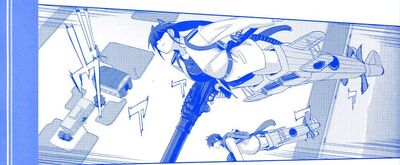
Backpacked Units
It is mostly based on interwar period fighters such as Bf109 and Ki-10 and has much lower top speed. However, they were sometimes more agile than the new Striker Units due to its lightweight nature. Known users of this old model were Kitagou Fumika(Nagashima A4N) and Adolfine Galland(Bf109). Any witch that had been fighting before the Second Neuroi War had probably used this model before.
Prototype Strikers
During the early development of Dr. Ichiro Miyafuji's work several Prototypes were developed by several counties. During this time many problems occurred that helped further the research and development of what would become the Striker Units that would fight the second Neuroi war. One problem that was found was that, unlike the Backpacked Strikers, the new ones had a far greater age limitation for witches to use. While a witch could use a Backpack Striker well into their 20's, the new ones had an age limit of 19-21 years of age. The early prototypes also had a flaw that carried into the first production Striker Units of using a great amount of magical energy. Many witches burned out their entire lifetime of magical power during the development phase.
Prototypes that were developed during and post second Neuroi war also had their fair share of complications. During the Romagnaian occupation by the Neuroi, Ursula Hartmann developed the first Jet Striker Unit prototype, the ME-262 Swallow, which was delivered to the 501st JFW for testing. It was initially tested by Romagnaian witch Francesca Lucchini who, shortly after starting it, felt something was wrong with the unit and leaped out. It was therefore handed off to Gertrude Barkhorn. Initial testing looked promising. The 262 set a new altitude record of 16,000+ meters. Its second test for armament and firepower, was also a success, but it quickly became apparent that it drains the witch of stamina. During its third test of speed Barkhorn fainted and crashed into the Adriatic sea. It was discovered then that the 262 had a fatal flaw that made it too dangerous to fly. After waking up Barkhorn was quoted as saying "Prototypes and trouble go hand in hand." The Prototype was then locked away and was scheduled to be sent back for further development. However after scrambling to intercept a Neuroi, it was soon discovered to be too fast and maneuverable even for Liberion Witch Charlotte E. Yeager. Barkhorn, defying orders not to use it, broke into the hanger and took off in the 262. She arrived just in time to save Yeager from being caught between two sections of the Neuori which had surrounded her after her gun had jammed. She quickly dispatched the Neuroi, but soon fainted again. The 262 started to accelerate uncontrollably and would soon drain Barkhorn of all her magical powers and subsequently crash and kill her. However thanks to some quick thinking and going supersonic again for only the second time, Yeager was able to catch up and pull the emergency release cable on the 262. The 262 Striker Unit detached from Barkhorn and subsequently fell to its destruction. The remains of it were sent back with Ursula Hartmann.
Post war, development of Jet Striker prototypes became the main focus of development